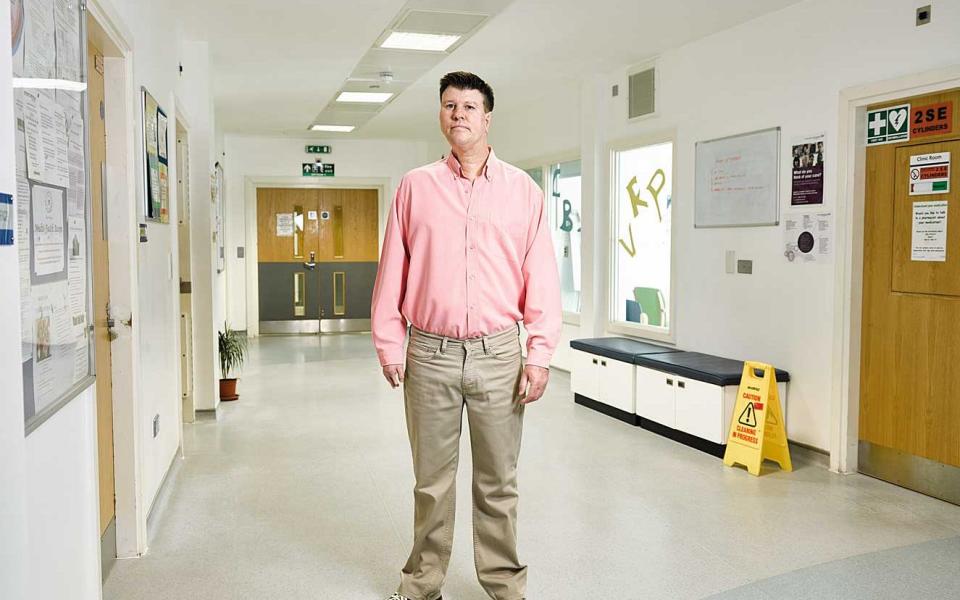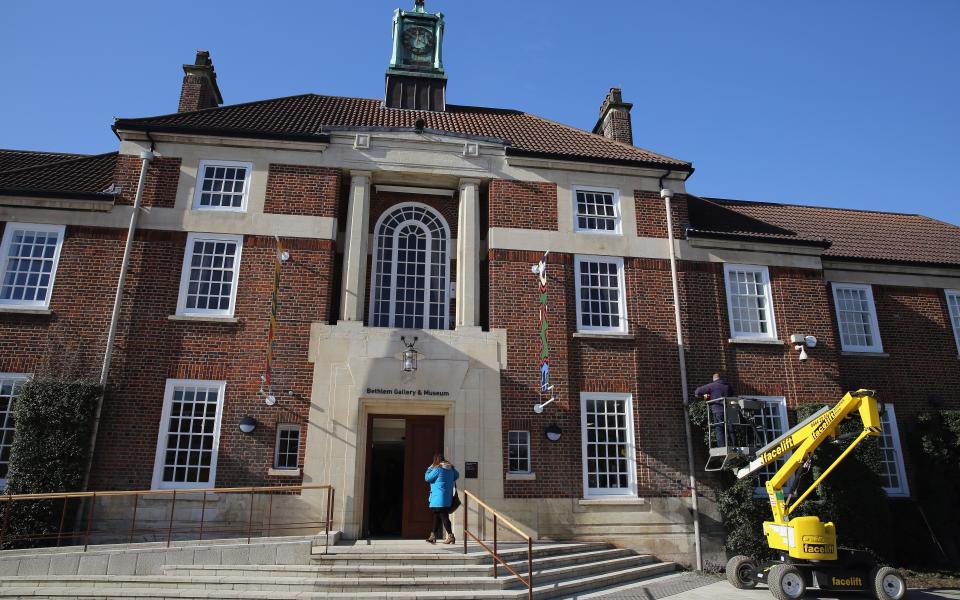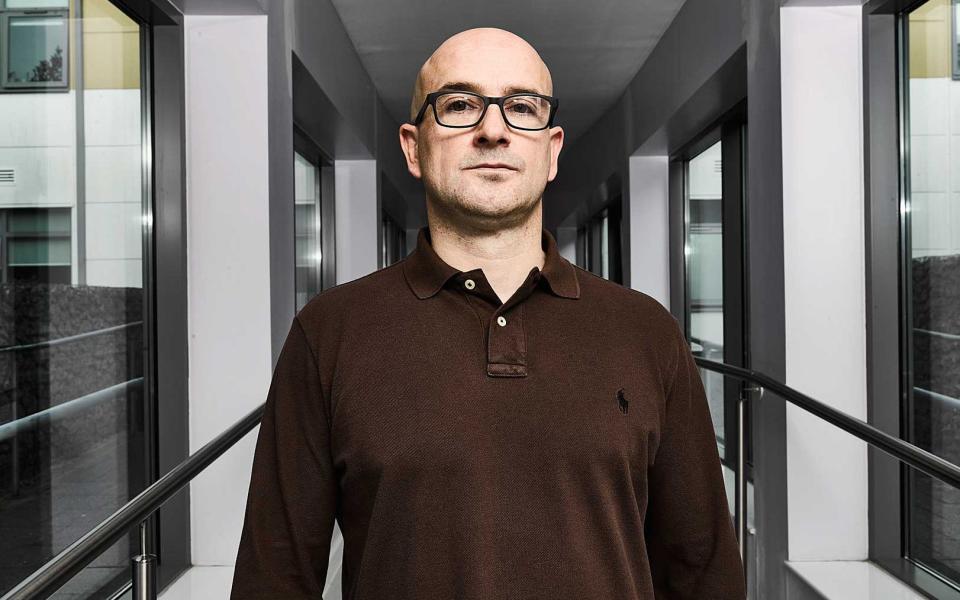Inside the psych ward: Can Britain's most dangerous criminals really be rehabilitated?
Rapists, armed robbers, arsonists… At Bethlem Royal Hospital, medical teams try to rehabilitate some of Britain’s most violent, mentally ill patients. The Telegraph gets a rare glimpse of the secure wards.
Tony is showing me around his room. In many respects, it is the typical bedroom of a single 36-year-old man. There are four pairs of trainers neatly lined up against the skirting board. A photograph of his daughter on the shelf. A grey hoodie lying on the floor where he forgot to hang it up. Hair gel in the bathroom. A desk with a music system and some garage CDs.
But in other, more subtle, ways the room diverges from the norm. The window only slides open a few inches. The mattress is wipe-clean. The bed is fixed to the floor. The hangers in the wardrobe are cardboard, not wire. The door has a small rectangular aperture through which medical staff can check on Tony’s progress.
Tony is a patient at the Bethlem Royal Hospital. His room is in River House, a medium-secure psychiatric unit for adults, many of whom have committed violent crimes and have been judged too mentally ill to be in prison. Tony has paranoid schizophrenia. In the past, his condition has been severely aggravated by the use of drugs.
He has 36 convictions dating back to 1997, one of which was for violent assault. For the 250 staff, who face daily threats to their physical safety from the 120 patients, it is one of the most dangerous places to work in the NHS.
Four years ago, patients from one of the wards besieged the nursing station and made threats to rape and kill staff. ‘Our job is to treat individuals, to get them well and keep them safe,’ says consultant Dr Tim McInerny. ‘But it’s also to keep the public safe, and that can be a conflict of interest at times: my patient might want to be discharged, but I’ve got a duty of care to the public also.’
Little is known about the work that goes on at Bethlem. For decades, the world of forensic (crime related) psychiatry was shrouded in secrecy. The South London and Maudsley NHS Trust can trace its roots back to 1247, when the hospital was founded on the site of what is now Liverpool Street Station.
Four years ago, patients from one of the wards besieged the nursing station and made threats to rape and kill staff
It became known colloquially as Bedlam – a name synonymous with madness, depravity and cruelty. Today, the Bethlem Royal is situated in a red-brick 1930s building in a leafy part of Beckenham, Kent. There is a café serving Costa coffee and an art gallery in the grounds that features the work of its patients and was opened in 2015 by Grayson Perry, a patron.
Yet a certain stigma still remains. Generally, the only time the public hears about the hospital is when something goes wrong. Then, there will be a slew of negative headlines. Patient Reece Davis was arrested in May on suspicion of attempted murder after stabbing a man while on escorted leave for hospital treatment.
In September, Bethlem Royal was in the news again after an inquest determined that a lack of risk assessment and an up-to-date care plan contributed to the death of 15-year-old Chris Brennan. But over the past year, the hospital has opened its doors to a camera crew for a groundbreaking Channel 4 documentary, Life on the Psych Ward.
The aim was to demystify the treatment process, and to show patients like Tony as more complex individuals than the ‘monsters’ of tabloid imagination. The Bethlem Royal houses one of the leading forensic psychiatric units in the world and offers a combination of medication and talking therapies.
In the past eight years, Dr McInerny has discharged 160 patients. Around 30 of those had committed murder or manslaughter and only four of them reoffended. An average stay in the hospital’s medium- and low-secure units lasts between two-and-a-half and three years and reoffending rates are around seven per cent.
By contrast, the reoffending rates of those coming out of a mainstream prison are 40-60 per cent in the first two years. It is undoubtedly expensive: treatment here costs £165,000 per individual per year. But, says Dr McInerny, ‘Because our results are so good, politicians are happy to fund it.’
Tony has a long road ahead of him. He has been allowed out on escorted day release, but tends to violate the rules. When I meet him, he is annoyed his privileges have been suspended because his electronic ankle tag showed him venturing beyond the hospital perimeter. Tony denies having done this.
His doctor, Cheryl Hartley-Brown, thinks he was probably trying to smoke a cigarette by getting as close to the boundary as possible (the Bethlem Royal is a smoke-free zone, partly for health reasons but also because a lot of patients here are convicted arsonists).
A very brief history | Bethlem Royal Hospital
‘Tony’s thoughts are very disordered,’ says Dr Hartley-Brown. His schizophrenia is compounded by his low IQ and past problems with drugs and alcohol. Although frequent checks are carried out, cannabis or so-called ‘legal highs’ are routinely smuggled on to the wards. One visiting family member hid a bag of cannabis in the bottom of a Pot Noodle carton.
On other occasions, patients have dropped fishing lines with £5 notes attached through the windows of the ward below to exchange for stimulants. ‘Often patients try to make sense of their illness or mask their symptoms through drugs and alcohol,’ says Dr Hartley-Brown.
‘I think Tony probably has very little insight into why he’s here. He has what I call “islets of lucidity” – little pockets where he seems to remember all the difficulties he got into using drugs, and then it’s gone. It’s a little whiff of understanding. It’s ephemeral.’
Tony is an imposing presence: tall and broad, with a lumbering gait. His blue eyes seem to look at you without ever quite focusing. He has dark hair and small, surprisingly delicate hands. Today, he is wearing jeans and a checked shirt, his belly straining at the lower buttons.
He overslept this morning and takes a while to warm up but, when he does, he can be engaging. He talks about EastEnders, football and his hope that, when he’s out of here, he’ll be able to earn a living as a gardener. On first meeting, you wouldn’t think that Tony has been in and out of secure institutions since he was 18. He seems vulnerable and essentially harmless.
In fact, he has attacked staff on the ward and his mother, Maggie, still lives in fear of him turning up on her doorstep. Does Tony know why he is here? ‘I don’t know,’ he says. Does he think he has a mental illness? ‘I don’t know. It could be. I reckon I’ve got split personality disorder.’ Does he believe he needs medication?
I am introduced to a convicted arsonist: a man of slight stature who is also a gifted artist. His works, I’m told, are exhibited in the Tate
‘I don’t know if I need it but if I am told I need more medication, I’ll take it.’ Then, just as Dr Hartley-Brown described, there is a glimmer of lucidity: ‘I’ve got to sort my life out,’ he says. ‘The staff are there to help me but I can’t get it into my head.’ He wants a future where he has a job, ‘and I come back home and all the housework’s done. I just want a normal life.’
There is no such thing as a typical patient at Bethlem Royal. There is John, who was born in Zimbabwe and suffered sexual abuse and bullying as a child. He has a personality disorder and has been residing in secure institutions for 22 years. When he drinks, he becomes unpredictably violent and, in 1998, he was found guilty of attempted murder after stabbing a man 13 times. He had a fear of ‘people looking [at me], pointing’.
Then there is Toby, who has paranoid schizophrenia, and firebombed his parents’ house two years ago. He converted to Islam in prison and has had jihadist fantasies.
And James, who is serving a life sentence. In 2000, he was doing time for armed robbery in prison when he launched an unprovoked attack on a fellow inmate with a weapon made from a toothbrush and a razor blade. He has a personality disorder that affects the way he feels about relationships. Again, there was a history of neglect and abuse in his early life – one of the worst that his doctor had ever seen.
At River House, James has completed a 14-month treatment programme involving extensive therapy. As part of this, he drew up an ‘offence cycle’ to pinpoint key moments of his life that might have caused his later behaviour. ‘James is completely aware,’ says Dr Colin Campbell, a consultant forensic psychiatrist. ‘He would be able to speak very fluently about the factors around his offence and what led to it.’
As a result, James has been allowed out on escorted day trips. On one occasion, he mislaid his wallet, which caused a stressed outburst. But he handled it fairly well. ‘Now I’m here, on a journey to build someone I’m proud of,’ James says.
The problem is working out how much what the patients say inside the secure hospital environment is actually what they will prove capable of doing in the outside world. Assessment, says Dr Campbell, ‘whilst evidence-based, can never be an exact science’.
It’s a fallacy that mental-health conditions cannot be treated. They can. It simply takes longer and requires more effort
But then there are the patients who offer flashes of a different kind of life. On one ward round, I am introduced to a convicted arsonist: a man of slight stature who is also a gifted artist. His works, I’m told, are exhibited in the Tate. Another patient has decorated his mobility scooter to look like a silver fire engine.
When I mention that many of them seem perfectly amenable, Dr McInerny nods, ‘Medical students will come to me and say, “Tim, this guy, I’ve spent time talking to him. He’s a rapist… but I like him.” Because no matter how bad something is they’ve done, there are good points to everyone.’
If there is no one-size fits all diagnosis for the patients here, there are certain recurring themes. Most of them are male. Time and again, I hear of child abuse, often followed by smoking cannabis and dabbling in alcohol and other drugs as teens.
And although the patients might sporadically appear innocuous, the staff never lose sight of the fact that they are dealing with damaged human beings. Security is high. River House is only accessed through double-locking doors and a fingerprint-recognition system. A fence runs all the way around the outside of the building.
Still, not everything can be foreseen. Dr Lade Smith mentions an occasion when she was punched in the head by a male patient in the intensive care unit. ‘Well, it hurt, obviously,’ says Dr Smith now. ‘I was quite upset at the time. It’s shocking… You find yourself thinking, “What could I have done differently?” You blame yourself a bit.’
When she went home that evening, her husband was ‘not happy’. ‘He is not a psychiatrist. It’s hard for him not to think, “Isn’t this person just bad?” and you have to explain, “No, he’s just had a really difficult life.”’ Her way of coping is ‘to try and understand it: where does it come from? How can we reduce the likelihood of it happening again?’
Most of the patients are male. Time and again, I hear of child abuse, often followed by smoking cannabis and dabbling in alcohol and other drugs as teens
She laughs when she describes going to dinner parties and the guest next to her asking what she does. Some will be intrigued and pepper her with questions. For others, ‘They still think of films like One Flew Over the Cuckoo’s Nest and that was 40 years ago. I know [care] has got better, but everyone else doesn’t.’
And arguably, the most eye-opening aspect of life on the psychiatric ward is not the horrifying crimes of some of its most dangerous patients, but the good-humoured dedication and skill of its staff. It’s a fallacy that mental-health conditions cannot be treated. They can. It simply takes longer and requires more effort.
It might mean life for a patient will never quite be the same again and the staff aim to manage that expectation, to prepare them for existence outside the hospital walls. ‘It’s not a case of somebody bad becoming good,’ says Dr Hartley-Brown. ‘It’s about someone ill who needs to become well.’
All of the doctors I talk to say they chose to specialise in psychiatry because of a fascination with humanity. They wanted to ask questions, to listen, to gain greater understanding of subtle, challenging illnesses. It was simple, they tell me: they liked people and they wanted to find out more about them.
Life on the Psych Ward is on Channel 4 in the spring

 Yahoo News
Yahoo News 





